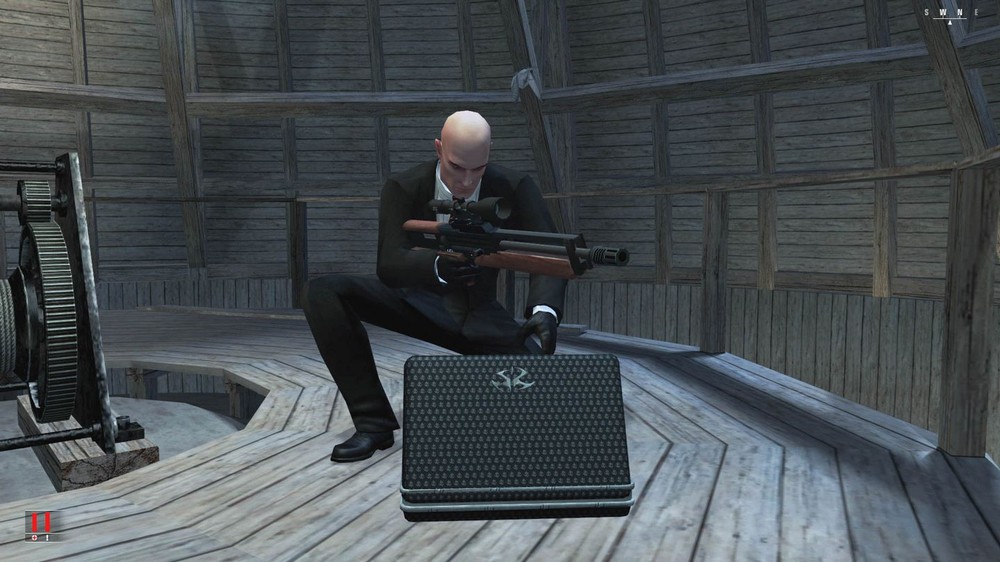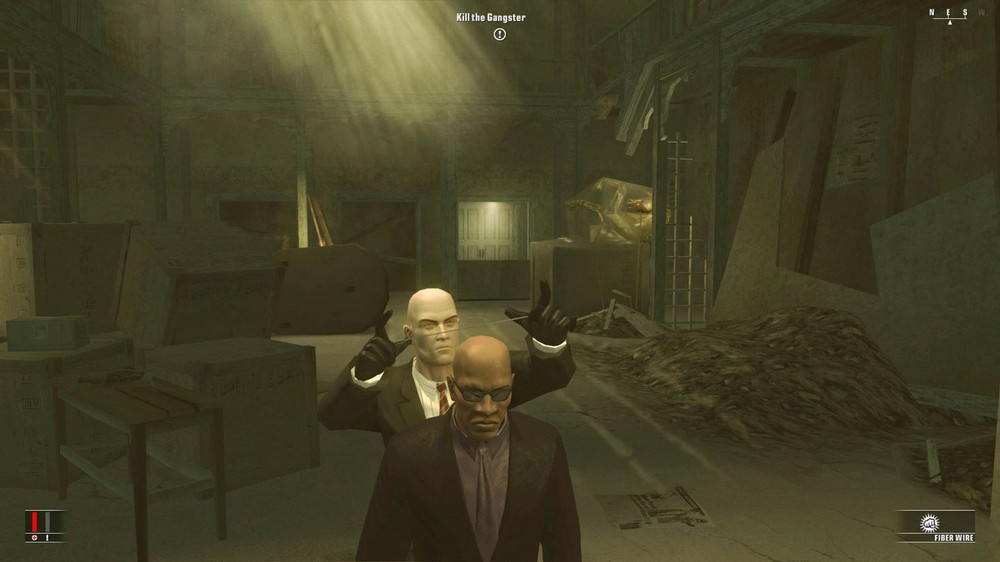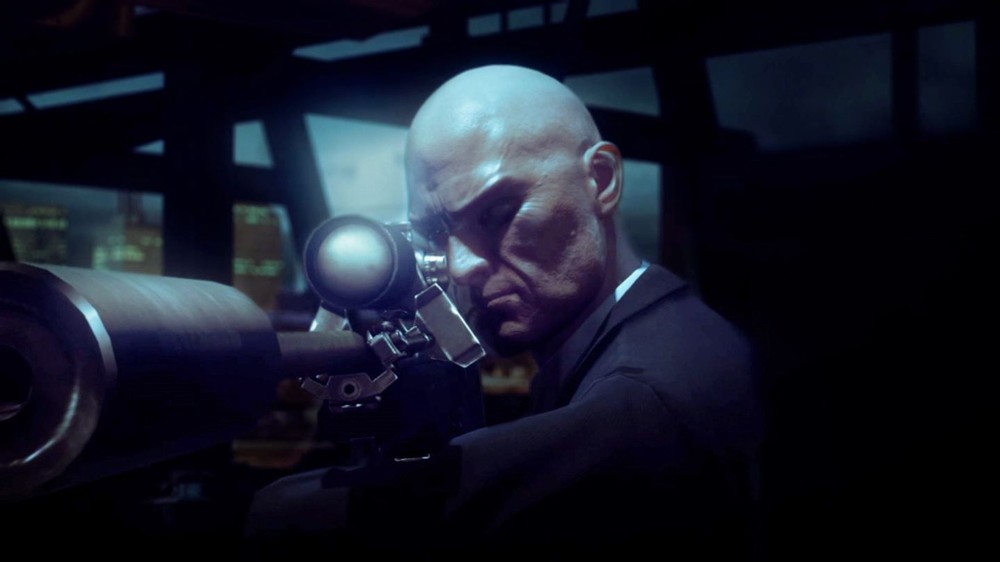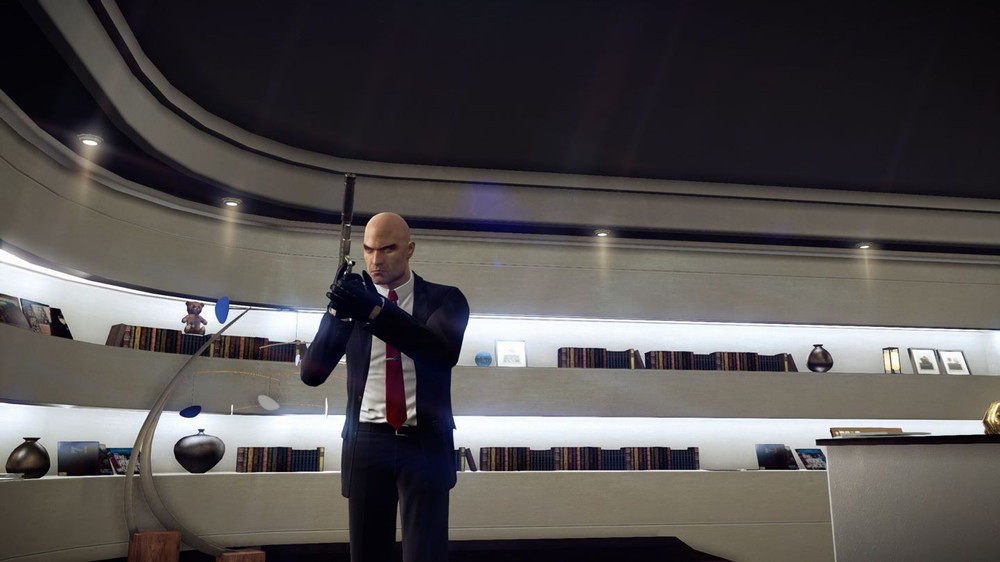While I’ve never actually reviewed a Hitman game before I have played all of them…repeatedly, so when the Hitman HD Enhanced Collection showed up for review it seemed like a good time to revisit the two games that make up this remastered collection; Blood Money and Absolution. The “collection” is merely two standalone games bundled under a single price, which makes it nice if you only want to install one or the other but it would have been nice if they were actually sold separately. The “enhanced” visuals are sure to impress whether playing in 1080p or 4K; both achieve a smooth 60fps and some fancy new HDR lighting effects along with increased texture resolution, upgraded texture formats, super-sampling, upscale support, heightened shadow map and mirror resolutions, improved lighting. Even the controls were tweaked for more responsive gameplay.
Hitman: Blood Money HD
First up was the 2006 Blood Money, which having never looked better still shows its age visually and in game design. It was oddly familiar and a bit shocking standing on the pier outside the abandoned amusement park for my tutorial on assassination. There is a binding narrative to the 13 missions setting up a series of flashbacks that highlight our killer’s exploits over the past several years. The hub to these events is an interview between a journalist and a mysterious disfigured man who has been hunting down Agent 47 during this time. As he recounts those events we get to actually play them.
Even more disturbing, other agency assassins have been killed in what turns out to be a huge conspiracy revolving around cloning and the next presidential election. Sensing that he may be the next target, Agent 47 travels to America where he attempts to carry on with business as usual while trying to stay alive and expose the plot against the ICA.
While I have regularly enjoyed the previous Hitman games I did find them a bit linear. You could always tell what the designers wanted you to do and the entire game ended up being more puzzle than action. Blood Money really opens things up allowing you unparalleled freedom to approach each of the 13 assignments however you see fit. It also provides for “thinking on your feet” so if things don’t go as planned (as they seldom do) you can improvise with great success.
Compared to the controls and UI of the recent Hitman games the controls for Blood Money seem antiquated. The context sensitive interface is tied to the environment, so when you get close enough to an object any of several options will appear next to the persistent button map in the top-left corner of the screen. This allows you to quickly pick-up, drop, drag, dispose, or hide items inside others with a quick and intuitive button press, but it also constantly reminds you that you are playing a game.
Walking and running around is handled with the analog stick, which has never been more important since your ultimate goal is to not attract attention. It’s usually prudent to walk – not run – especially when guards or other suspicious observers are nearby. You can always gauge your current attention level with the handy meter that resides next to your health bar. If it gets too high you might need to change clothes or location. If it turns red, you need to prepare to defend yourself.
The variety and size of the missions have also been improved and you will now find yourself going up against much smarter targets, sometimes even other hitmen that fight back with as much ferocity as yourself. Each chapter typically has multiple objectives, not always “hits”, but sometimes you might even have to protect somebody or retrieve an object or sensitive data.
There are several systems in place that dynamically play out with the game and your performance. The first is your payment, which is based on how well you perform the mission minus any penalties. If you take a custom weapon into a mission and leave it behind you will pay a fee, as you will if you fail to leave wearing your stock black suit and red tie. Admittedly, paying $5,000 to not have to risk going back for your suit might seem like a fair price, but it’s the principle of the thing that compelled me to avoid such fines.
Notoriety is another cool feature although I don’t think it was fully exploited, or at least it was too easy to maintain your anonymity. At the end of each mission you are ranked on several criteria including witness, caught on camera, noise and violence levels, etc. This is converted into a number on a 100-point scale. For a scaling fee you can bribe witnesses, the cops, or even assume a new identity, thus lowering that number. Notoriety carries over across all 13 missions, so if you don’t keep that number low it makes it easier to get noticed in subsequent missions.
Security cameras also present their own unique challenges. You can try to disable them before you pass by, or hug the wall to stay out of their range, but if you are captured on tape you’ll want to locate the security room and collect the tape to destroy any evidence of your having been there. Oddly enough, it doesn’t seem to matter if you are in disguise when caught on tape. Agent 47 is pretty memorable in his trademark suit, but given all the opportunities for disguise, passing a camera dressed as Santa Claus should be fairly inconspicuous.
Disguises are cleverly integrated into the missions and allow you to gain access to populated areas otherwise inaccessible. Some levels ramp up the difficulty by having “zones” within the game and only certain characters can get into those areas without trouble. There might be indoor guards and outdoor guards, or an intern versus a doctor or in the case of the Heaven & Hell party, two very distinct guest lists and appropriate costumes. And then you have certain trump characters (like the magazine photographer) who can go almost anywhere without question.
Your best friend in Blood Money is the map where you can bring up floor plans for every level and area in the mission including real-time updates of every person in the level. It’s all color-coded so you know where your primary targets are in relations to guards and random civilians. Points of interest are also called out as well as ICA drop zones and the exit. The game never explains how this map works, and it does give you a significant and often unfair advantage by allowing you to observe patterns and plan your strategy.
When you aren’t paying off people to keep your identity secret you can spend your loot on dozens of upgrades for each of the weapons in the game. It can cost millions of dollars to fully upgrade each weapon and not all upgrades can be equipped at the same time, so you can fine-tune, not only your weapon selection, but various features of that weapon before starting each mission. The agency will place larger weapons that you cannot sneak into some locations in special ICA drop zones within the level.
The newspaper between missions is a great idea that somehow never continued further into the series. It really makes you self-aware of all your actions during the mission, and it only takes a few headlines to figure out how to manipulate the media so you can create the illusion of a gangland slaying or an “inexperienced hit” by intentionally priming the crime scene. Headshots create suspicion but 20 rounds into the body is just sloppy – the paycheck is the same. Hiding bodies is good during the mission but also creates extra intrigue at press time.
Reading the feature story will give you an uncanny recount of your recent activities including weapons used, bullet casings found, and bodies discovered. I was a bit disappointed (or should I be impressed) that the paper managed to report bodies that I had burned or thrown into the river. The paper should have at least labeled them as “missing”. The rest of the paper usually has some clever articles, a quote of the day, and an ongoing report for the presidential election that plays a bigger role in the story than you might think.
Another awesome improvement to the franchise is accidents. This feature is so compelling that I spent way too much time trying to make every hit look like a mishap versus a hit and best of all, accidents are generally beyond suspicion, keeping that notoriety figure very low. The only downside to accidents is that the opportunities are pretty much given to you in that you don’t have to figure them out. Just walk by the appropriate object (usually highlighted on the map) and the option to set the trap is given.
While collateral damage is generally frowned upon, I found it quite difficult to simply knock out somebody. One hit too many and they were dead and bleeding. It was also hard to disarm somebody and then not shoot them with their own gun, often alerting other guards. And while observer AI is really good, they never seemed to notice blood stains on the floor, even if I did hide the body. Then again, having Agent 47 carry around a rag and stain remover might just be a bit too realistic.
The best thing about Blood Money is the freedom to explore dozens (if not more) possibilities in how to accomplish the mission objectives. After playing several of the missions numerous times and trying different tactics I checked out the official strategy guide and found that I still hadn’t done it the way they had, and often my solutions were more thoughtful and fun.
For the most part, Hitman: Blood Money HD looks like the PC version with better lighting and improved textures. The original game, while great for its time, was certainly lacking in visuals. The real power on display is when you factor in these environments that are often packed with people. Mardi Gras alone has hundreds of dynamically scripted people partying in the streets; along with guards running their own scripted patrol routes. And if you want to see dynamic panic in action, just walk into the parade and open fire. Other levels like the Heaven & Hell party, the wedding, and the Christmas party at the adult magazine mansion come loaded with all sorts of clever characters doing their own thing.
Best of all, at any time you can become almost anybody in the game. Some of the best visual moments in the game are watching Agent 47 do his mission in a Santa suit or dressed as a clown with a big orange wig. He even makes a convincing garbage man. Unfortunately he never got to dress as a Vegas showgirl.
The original Jesper Kyd soundtrack is just as awesome as it was 13 years ago with an epic score that combines the rich sound of the Budapest Symphony Orchestra with a few licensed tracks. From the opening operatic theme to the mid-game music to the closing credits, you will be captivated with this soundtrack. Sound effects are rich and dynamic with a variety of weapon effects for each of the guns that change as you equip new mods. The fully loaded Silverballers sound like something from a sci-fi movie. There are all sorts of environmental sounds, weather, waterfalls, birds, and the crowd noises that can range from ambient party chatter to the roar of a Mardi Gras celebration going full tilt.
Dialogue is outstanding starting with a topnotch performance for Agent 47. He delivers his lines with an icy coldness and there is so much idle chatter going on that you are compelled to eavesdrop more often than you normally would. Being in the right place at the right time might not only give you a valuable verbal clue, you might just get to provide some additional “pool services” to the lady of the house.
There are 13 missions in Blood Money including the opening tutorial level and quite possibly a bonus playable epilogue if you are clever enough to figure it out. Each mission can range from 20-60 minutes depending on how methodical you want to be. The amount of replayability is astounding. I typically play these games straight through but for once I was compelled to keep playing missions over and over saying to myself, “I wonder what would happen if I did that”, which usually opened more doors to that same question sparking more replays.
Hitman: Blood Money’s gameplay may seem a bit antiquated by today’s standards but it did introduce some great new ideas that remain in even the latest installments. Blending thoughtful tactics with spontaneous actions that dynamically change with the current situation and plenty of moments of adrenalized, butt-clinching suspense, Blood Money is in a league all its own and it will never look and play better than this.
Hitman: Absolution HD
Jumping ahead six years to 2012 saw the triumphant return of Agent 47 in Hitman: Absolution. Obviously the tech had increased during that time and Absolution was setting new heights when it came to graphics and stealth gameplay, so the HD Enhanced version of this game might not be the huge leap in quality as Blood Money, but it’s still mighty impressive bringing the Xbox One version of the game almost to the same level as a high-end PC.
Absolution continues the tradition of “freedom of choice” by providing you with these elaborate scenarios set in highly detailed levels, often populated with dozens of brilliantly designed AI bystanders. Your mission objective is clearly laid out but the way you execute that mission is entirely up to you. It’s no wonder I played through the opening prologue tutorial level five times before moving on to the first mission – there were just so many ways to approach not just the final target, but every encounter leading up to her.
The story involves 47 going after a rogue agency handler who has wiped the organization’s hard drive and gone into hiding in a luxurious safe house in Chicago. It is there we meet up with 47 as he pulls up in an ice-cream truck and we begin an expertly guided tutorial that teaches you the new stealth mechanics as well as 47’s new powers of observation, body concealment, distraction, and multi-shot takedowns. By the time the tutorial is over 47 will have rescued a young girl who has secrets of her own, but rather than turn her over to his boss he stashes her in a monastery, making 47 the target of his own agency’s manhunt.
Hitman has always been about experimentation and even a bit of trial and error. Sometime the solution is obvious and other times it may take painstaking exploration of the entire level to unlock all the possibilities. One of the earlier missions in Chinatown you are tasked with killing a target who is heavily guarded by police. The obvious tactic would be to take down a lone cop, use his disguise to get close and strangle him, but there are so many other more interesting ways to get the job done; many of which I didn’t even realize until the final mission tally screen where these methods are revealed. Somewhere in the level is a sniper rifle. You could also find some poison and dose a plate of food, or in my ultimate solution, I planted a car bomb, hit the car to trigger the car alarm and when the target came to investigate, detonated the device remotely and casually walked to the exit. Ironically, this method ended the level after only five minutes of play, but it also netted me the highest score.
Scores and checklists give Hitman: Absolution incredible replay value, especially since many of these levels can be finished in less than 30 minutes once you know the “secrets”. The entire time you are playing an ongoing tally of your progress will be shown in the corner in the form of a score that is compared with your friends, your region, and the entire world. There are goals that are checked off for completing your mission in each of the various methods as well as unlocking guns and disguises for all the possible NPCs in each level. Perhaps the most difficult achievement is completing the Suit Only goal, as this requires you to finish the level without using any disguises. Obviously, this method requires more action and gunplay than others, and that is where the new point-shoot system comes into play. Using your instinct you freeze time and mark your targets then watch them all go down in a hail of glorious scripted gunfire.
Hitman is all about stealth and despite your trademark silverballer pistols that can be dual wielded or used alone and silenced, you have your other trademark weapon, the piano-wire garrote that you can keep readied yet undetected. Your new instinct mode allows you to scan the area for enemies as well as key objects you can interact with. You no longer have an endless supply of coins to toss to distract the AI, but you can find other objects that serve the same function. Then it’s up to you whether you slip past or strangle them while their back is turned. You’ll want to stash dead or unconscious bodies so they aren’t detected by patrolling guards, and there are usually ample boxes, lockers, crates, or other human-size hiding spots that can hold one or two bodies including yourself if you need a quick place to hide.
Disguises play a huge part in Hitman by allowing you to access new areas of the level without drawing undue attention, but even disguises have their own rules. Disguises only get you into certain areas and anyone wearing the same outfit has a greater chance to see through your deception, so if you are dressed as a landscape worker you need to be careful when approaching other landscape workers. Of course, you can also enhance your disguise with a momentary use of Instinct to blend in.
Using your instinct, either to analyze the levels or blend into the crowd, will slowly drain your instinct meter, but this can be refilled by simply doing your job. On the higher difficulty settings the instinct feature will no longer show useful items in the level and manual checkpoints will be disabled, adding a bit of pressure to the mission. While the game auto-saves at key moments, you will occasionally find optional glowing checkpoints to save your progress – usually right before a particularly challenging situation. 
At times, Hitman: Absolution is more of a puzzle game than an action game. Unlike any other game in the genre, your situational awareness of not only your surroundings but the people in those areas and all the tools at your disposal are paramount in completing the levels and earning top scores. While it is entirely possibly to trigger an alarm and still finish the level, the gamer in me had me clicking on the Restart Checkpoint countless times in the game, or better yet, once you “blow the mission” you can race around the level gathering valuable intel for your next attempt or trying to locate the hidden evidence in each level.
Absolution is a 10-hour game that will take you 20-30 hours to complete out of the sheer joy of experimentation and original replay value, but that doesn’t even include the Contracts mode; perhaps the most ingenious aspect of Absolution. Contracts allows gamers to create their own missions, not with some fancy level editor, but by merely using the existing missions and letting you create a custom rule (or restriction) set; anything from limiting the weapons used to the disguises worn to imposing an impossible time limit for completion. You can then share these contracts with the online community and compete for the highest scores. For something so simple, Contracts is deceptively addicting, not only in creating your own diabolical rules, but attempting the ones created by others.
The HD Enhanced version of Absolution looks fantastic with all sorts of improvements to lighting and shadows and some crazy J.J. Abram lens flares that almost get distracting at times. The colors are super-saturated giving this game an original style slightly detached from reality. The lighting, textures, animation, and sheer spectacle of complexity blew me away level after level. There is one scene early in the game where you open these doors and enter Chinatown, and the way the designers framed the event then pushed the camera into this congested area with hundreds of people milling about was jaw-dropping impressive, then the designers go even further with their epic crowd system in a later level as you make your way through a congested train station.
To complement the outstanding visuals is a masterful soundtrack, flawless sound effects, and impressive voice acting by some major Hollywood talent. The open credit sequence reads like a major motion picture. Since you’ll be spending a lot of time either eavesdropping or blending in using a disguise, there are numerous chances to overhear some amusing conversations, some of which may even provide a valuable clue.
When it comes to Agent 47, Blood Money will always have a special place in my heart, but given the six years of evolution for stealth-action gameplay, Hitman: Absolution was definitely the crowning achievement for this franchise in 2012 and remains one of my favorites even today. The game is more cinematic and more story driven than ever before, the Instinct is a much better alternative to the old map view, and you have never been given this much freedom when it comes to killing in a video game. Absolution is a brilliantly designed game, perfectly executed, and will never get better than this new Enhanced edition.
So, to sum it up, Hitman HD Enhanced Collection delivers two incredible installments in a fantastic franchise, totally updated for the latest gen consoles and visual fidelity. Seeing these games in 4K 60fps is a sight to behold, and for those who have never played a Hitman game (or at least these Hitman games) then you won’t find a better time to jump in. And for those who played the originals like me, let me assure you this is a great trip down memory lane and definitely worth revisiting if you have the latest gen console and a 4K display. The classics never die…they just get remastered.











